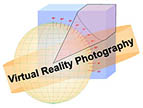

![]() Ask the VR Photography Experts
Ask the VR Photography Experts
![]()
Q: What do I need to shoot QTVR panoramas underwater?
![]()
A: The best advice I can give to anyone wanting to shoot VR imagery underwater is... don't let yourself get killed in the process!
It is so easy to get caught up in the details of your photography efforts, that you overlook critical safety concerns in your diving (or even working on a boat). Don't even think about shooting underwater VR until you are a competent and safe diver first. Then, as diving becomes second nature, you can begin thinking about underwater photography... but start with the basics and simple shooting. Then move on to underwater lighting and eventually VR. Never forget about your safety in the water. NO picture is worth dying over. There is so much that can go wrong while you are underwater, and the many distractions of photography can keep you from recognizing them in time to prevent accident, injury or death.
I am by no means an expert diver, but I try to be competent and cautious. My experience and position allowed me to shoot the first underwater panorama specifically for QTVR in 1994 and the first inderwater iPIX spherical images in 1995. I made at least two such major mistakes (critical lapses of judgment -- basic dive safety) on that first underwater QTVR shoot in Monterey Bay, and was very lucky to survive the effort unscathed. My first mistake was that I did the dive alone in order to get the VR sequence, when my partners decided that it was too cold for them to get in the water. The second was that I let my air supply get down to almost zero trying to finish the sequence. Both were violations of cardinal rules of diving safety. The experience was a sobering one however, which I think about whenever I find myself tempted to cut corners safety-wise.
Safe today helps you dive again another day.
![]()
As for the photo equipment you'll need, it is very similar to that which you'll need for topside panorama photography with the exception that it all needs to be protected for use underwater.
Be sure to thoroughly rinse all your equipment in clean fresh water after every day of diving, and dry it out thoroughly. Water, particularly salt water, is extremely hard on camera gear. Also, be prepared for equipment accidents. They say there are two kinds of underwater photographers - those who have flooded their camera(s) and those who will. Take your time to check eveything before every dive, and then check it all again.
- Scott Highton